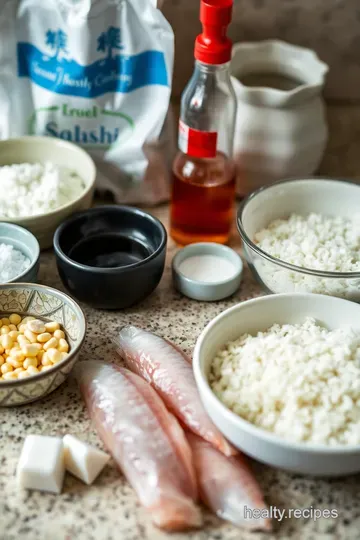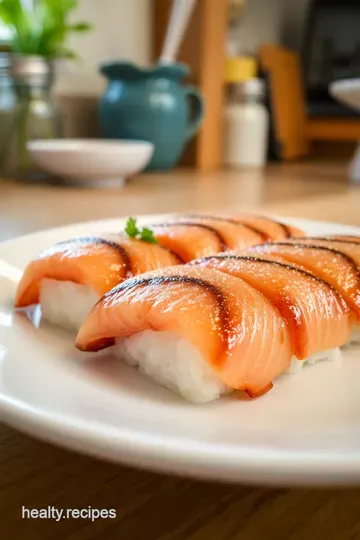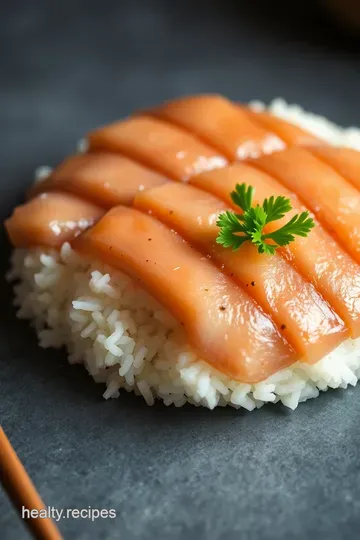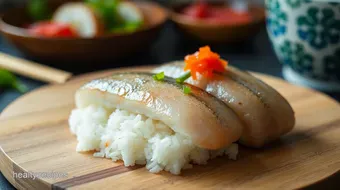Classic Mackerel Sushi (Saba Sushi) – The Taste of Japan’s Coastal Delicacy
Discover how to make authentic mackerel sushi with a simple curing method. Perfect for tasty nigiri and inspired Japanese grilled fish plating ideas.

- Diving Into Mackerel Sushi: A Coastal Classic with a Modern Twist
- The Origins and Rise of Mackerel Sushi
- What to Expect: Time, Cost, and Difficulty
- Why Mackerel Sushi Deserves a Spot on Your Plate
- Essential Ingredients Guide for Nailing Your Mackerel Sushi Experience
- Mastering the Professional Cooking Method for Mackerel Sushi
- Pro Tips & Secrets from My Sushi Journey
- Elevate Your Plating Game
- Storage & Make-Ahead Tips for Busy Foodies
- Get Creative with Variations & Seasonal Twists
- Crunching the Numbers: Nutrition You’ll Love
- Frequently Asked Questions
- Recipe Card
Diving Into Mackerel Sushi: A Coastal Classic with a Modern Twist
You ever had a sushi experience that totally surprised you? like, you thought you had to have salmon or tuna, but then boom—mackerel sushi shows up and steals the show.
Honestly, the first time i tried mackerel sushi, i wasn’t sure what to expect. the deep, oily taste paired with that perfect kiss of vinegar from the curing process was mind-blowing.
If you’re into japanese grilled fish or fancy trying a japanese mackerel recipe that’s a bit off the usual sushi path, this one’s for you.
Mackerel sushi, or saba sushi as the locals call it, brings together everything awesome about japanese fish recipes —rich flavors, bright acidity, and that knack for food presentation that you’d totally expect from a michelin star kitchen.
Plus, it’s a great stepping stone if you’re into studying food culture or dreaming of a day at culinary school .
The Origins and Rise of Mackerel Sushi
You know how some dishes just carry a little story in every bite? this sushi hails from japan’s coastal regions where fresh fish is life.
Before the era of sushi as we know it today, curing fish with salt and vinegar wasn’t just a savvy way to amp flavor—it was how folks kept fish safe for eating.
The tradition of curing mackerel in this way has stuck around, making it a classic favorite.
Fast forward to today, and mackerel sushi is popping up in food galleries and michelin food joints alike—proof it’s both timeless and trendy.
Whether you’re serving it outside table style at a backyard party or plating it up fancy for a special date night, this recipe hits all the right notes.
What to Expect: Time, Cost, and Difficulty
I won’t lie—making mackerel sushi takes a little patience. you’re curing the fish for a few hours, then cooking sushi rice perfectly, which alone is an art.
But compared to other fish recipes asian cuisine offers, it’s a medium level workout, no sweat if you take it step by step.
Cost-wise, it’s surprisingly budget-friendly. mackerel is often more affordable than pricier sashimi-grade fish, yet its bold flavor can easily fool guests into thinking you went all-out.
A couple of fillets, some sushi rice, and simple seasonings go a long way to produce about 16 spectacular nigiri pieces.
Perfect for a small get-together or just treating yourself without breaking the bank.
Why Mackerel Sushi Deserves a Spot on Your Plate
Mackerel is packed with omega-3 fatty acids, which are great for the heart and brain, so you’re doing your body a favor.
Unlike some sushi that’s just about the experience, this one’s a real nutritional win. i personally love that it feels fancy but is so straightforward to share at a family gathering or during holidays like new year’s or a cozy sunday get-together.
One cool thing is how it stands out next to other fish dishes. compared to raw tuna or salmon, mackerel sushi offers a smoky tang from the curing and vinegar that makes it pop.
It’s a bit like the difference between a regular coffee and one with a splash of something special—adds a whole new level of complexity without needing you to be a sushi master.
If you’ve ever drooled over korean mackerel recipe variations or been curious about salted mackerel recipe secrets, this recipe is your gateway.
Plus, i’ll share some fun plating ideas so your sushi looks as good as it tastes—because, hey, we eat with our eyes first, right?
Ready to whip up some mackerel magic? let’s get japanese mackerel and sushi rice ready and dive straight into the ingredients you’ll need.
Trust me, soon you’ll be impressing friends with your own little sushi bar at home!

Essential Ingredients Guide for Nailing Your Mackerel Sushi Experience
Alright, picture this: you’re outside at the table, summer breeze warm, your buddies around, and you’re serving up some mackerel sushi that tastes like it’s straight out of a michelin star joint in tokyo.
Yeah, that’s the dream, right? but to get there, you gotta know your ingredients like a pro. let me walk you through some essential details—from the basics to smart swaps.
Premium Core Components — The Building Blocks of Flavor
First thing’s first, let’s talk quality . when buying your mackerel, get fresh, sashimi-grade fish if you can. the kind that gives you zero fishy “oh no” vibes but instead that rich, oily goodness that makes japanese and korean fish recipes so crave-worthy.
Measurements:
for salt and vinegar cures (critical for flavor and safety in mackerel sushi), i use 1 tablespoon of kosher salt per 300g (about 10.
5 oz) of fillets . for sushi rice, 1 cup (200g) of short-grain rice with 1 1/4 cups (300ml) of water does the trick perfectly.
Precision matters for rice though—too much water and you’ll end up with mushy sushi, and no one wants that .
Storage and freshness:
keep your mackerel in the coldest part of your fridge, wrapped tight in plastic wrap or a sealed container.
That fish should ideally be used within 24 hours of purchase to keep it fresh. sushi rice? it’s best fresh but can be loosely covered for a few hours at room temp if you seal it with a damp cloth.
Once cured properly, mackerel keeps for about 2 days in the fridge . sneaky tip: always smell the fish before prep—if it smells too strong or ammonia-like, toss it.
Signature Seasoning Blend — The Magic Behind the Taste
You know, one of my favorite discoveries while studying food was how simple seasonings and aromatics can turn ordinary sushi into something that could belong in a food gallery or fancy restaurant.
For mackerel sushi, the seasoning’s a minimalistic dance.
Salt and sugar are your heroes in the curing stage. toss in a splash of rice vinegar , about 2 tablespoons (30ml) , to add that classic tang.
If you want a little more flair, consider pairing the curing with fresh shiso leaves or even a tiny sprinkle of toasted sesame seeds in the marinade—these can add subtle herbaceous notes and nuttiness.
You’ll notice regional variations if you peek into japan versus korean fish recipes. koreans tend to lean heavier on salt curing, while the japanese favor a gentle vinegar balance.
Both ways are winners, and the seasoning combo you pick will define your sushi’s character just like a michelin food critic on the hunt for the perfect bite.
Smart Substitutions — When Life Throws You Curveballs
Been there, done that—finding the perfect mackerel isn’t always easy. if you're in a pinch, atlantic or spanish mackerel can work as a decent stand-in.
Just make sure it’s fresh and suitable for curing.
Dietary twist? if you or your pals are watching sugar intake, swap the sugar in your rice vinegar marinade with honey or agave syrup.
It keeps the subtle sweetness but adds a little natural goodness.
Emergency replacements? don’t stress. if fresh mackerel is a no-go, pick up salted mackerel from your asian market to save time on curing (you’ll find salted mackerel recipes that show how to prep it for sushi).
Seasonal seafood swaps might include lightly cured trout or even smoked salmon for a different kind of umami rush.
Kitchen Equipment Essentials — Tools of the Trade
Honestly, i once tried making mackerel sushi without a sharp knife and nearly cried. if you want clean, precise slices, a sushi or fillet knife is your best friend .
Trust me, dull knives make a mess and kill the vibe of your plating ideas.
Don’t have one? A very sharp chef’s knife will do in a pinch. Prepare to be patient and go slow.
A rice cooker is hands down the best tool for perfect sushi rice every time. if you don't have one, a heavy-bottomed pot with a tight lid works too, but watch your timing carefully.
Keep some kitchen paper towels handy for patting dry your fish post-cure—moisture is your enemy in sushi assembly.
Lastly, don’t forget a bamboo sushi rolling mat if you ever wanna experiment with maki rolls down the line. when prepping your workspace, clear room because sushi making likes some space to breathe.
When i first tackled mackerel sushi , i messed up the curing times. thought 1 hour was enough. nope! it was fishy and floppy.
But after a couple tries, carefully following these guides, it became a highlight dish in my dinner parties. there’s something seriously rewarding about serving a dish that looks like it belongs in a culinary school showcase or a fancy michelin star meal, right? plus, you get to tell your friends about how you nail food presentation and even show off some korean mackerel recipe flair.
Now that you’ve got the lowdown on your ingredients and tools, we can move onto the juicy part: putting it all together step-by-step to make your own delicious homemade mackerel sushi.
get ready to impress!

Mastering the Professional Cooking Method for Mackerel Sushi
Alright, so you wanna nail that mackerel sushi like a pro, huh? trust me, i’ve been there—staring at fresh japanese mackerel wondering if i’m about to make magic or a mess.
Making sushi that could earn a nod from a michelin star chef isn’t just about throwing fish on rice. there’s a whole art and science behind it.
Here’s the lowdown on cooking mackerel sushi the professional way, packed with tips from my kitchen (and a couple of kitchen bombs i survived).
Essential Prep: Mise en Place, Timing & Safety—Get Your Act Together
First off, mise en place isn’t just a fancy culinary school phrase. it’s your best friend. before touching that salted mackerel recipe , get all your ingredients prepped and ready.
Measure out your salt, sugar, vinegar, and make sure your sushi rice is rinsed and draining nicely. i learned the hard way—in the middle of curing fish to pause and search for rice vinegar.
Total buzzkill.
Timing is everything. the curing stage for korean mackerel or japanese grilled fish doesn’t happen in a snap. expect 2 hours salted cure and 2 to 4 hours marinating in the vinegar mix.
So, plan ahead. don't rush this; skipping curing is like skipping the intro to your favorite song—just ain’t right.
Organization is key. keep your work area clean and separate fish prep from veggies or anything raw. cross-contamination is a no-go.
Plus, always use a sharp knife, preferably a sushi or fillet knife. dull knives make messy cuts and can lead to accidents—been there, “ouch” moment included.
Step-by-Step Like a Pro: The Play-by-Play
Here’s how I break it down when making Japanese mackerel sushi :
-
Cure the mackerel fillets : sprinkle kosher salt evenly, cover, and chill for 2 hours . then rinse and marinate the fish in a vinegar-sugar mix for 2- 4 hours .
This kills bacteria and firms up the fish, giving you that “just right” texture you see in fancy sushi joints.
-
Rice magic : rinse your sushi rice until the water runs clear—no cloudy water, no soggy rice. cook with 1:1.
25 rice-to-water ratio —i use my rice cooker for foolproof results, but a heavy pot with a lid works too.
Once cooked, stir in the sushi vinegar mix while fanning the rice to cool it down quickly. it’s all about that glossy shine and that perfect sticky-but-not-soggy feel.
-
Slice like a sushi chef : for saba sushi , slice the cured mackerel at an angle into neat, thin slices about 2.
5 inches long. keep the skin on—that’s where the flavor kicks in.
-
Assembly time : wet your hands (i use a 70% water, 30% rice vinegar mix) so the rice sticks less.
Grab about 20g rice and shape into a gentle oval—don’t pack it too tight! dab a bit of wasabi on the rice, place the fish on top, and gently press to seal.
-
Plate it like a Michelin pro: Presentation counts. Arrange your nigiri on a simple white plate, add pickled ginger on the side, and maybe sprinkle a few toasted sesame seeds for texture.
Expert Techniques: Because Details Matter
Let me spill some personal insights that changed my sushi game. first, temperature control during curing is crucial. always keep the fish cold (around 38° f or 3° c )—nothing ruins sushi faster than warm fish.
When marinating, don’t overdo the vinegar; it can overpower. taste as you go. also, if your mackerel looks dull or slimy, that’s a red flag—fresh is non-negotiable.
Quality checkpoints also include the rice texture—it should be sticky but not gluey. if your rice is too wet, your nigiri won’t hold.
Troubleshooting tip: If your fish slices fall apart, it might be under-cured. Patience with curing is worth every extra hour.
Success Strategies: Avoiding Rookie Mistakes & Making It Ahead
Here’s the deal: one common error is rushing the curing stage. it’s tempting, but your salted mackerel recipe depends on it for safety and flavor.
Another is overpacking rice—your sushi should feel light. also, avoid using cheap rice vinegar with strong artificial taste, it kills the vibe.
Want perfect results every time? stick to your timing. use fresh, sashimi-grade mackerel. practice rice shaping, it’s an art you develop with time.
Plus, wet your hands often to keep rice from sticking.
Oh, and here’s a neat trick for parties— mackerel sushi keeps well if assembled a bit ahead. just cover with damp cloth and refrigerate for up to 3 hours .
No one will suspect you’re serving fancy food made with a bit of prep love.
Wrapping It Up… But Stay Tuned for Additional Info!
So there it is—your roadmap to pro-level mackerel sushi . honestly, it’s this mix of studying food tradition, respecting japanese fish recipe techniques, and a dash of trial and error that gets you there.
I still remember my first stab at this; the fish was too salty, rice overcooked, but hey, that’s how you grow.
If you’re vibing with food presentation and aiming for that outside table wow factor, you’re on the right track. up next: additional information on plating ideas, flavor pairings, and even my top picks from food gallery inspiration to make your sushi not just tasty, but eye-catching too.
Stay tuned!

Pro Tips & Secrets from My Sushi Journey
Oh man, making mackerel sushi for the first time was kinda intimidating! i mean, michelin food level dishes always sound fancy, right? but honestly, once you get the hang of it, it’s almost fun.
Here’s what my little culinary school experience taught me—and what i learned the hard way.
First off: curing the mackerel properly is a game changer . i used to rush this step, thinking “eh, how bad could it be?” spoiler alert: it tastes totally different when you actually salt and vinegar soak it well.
The salt firms up the fish and dials back that strong fishy smell, making it taste clean and fresh like a proper japanese grilled fish dish you’d find in a fancy restaurant.
A quick time saver? while the mackerel is curing in the fridge, cook your sushi rice. get that rice-to-vinegar mix just right; in my experience, mixing the vinegar and sugar until fully dissolved makes the rice super shiny and sticky—the perfect base to hold that oily mackerel on top without falling apart.
And here’s a little secret: wet your hands with a splash of rice vinegar and water before shaping each nigiri .
Trust me, it keeps the rice from sticking to your fingers and helps shape perfect little ovals every time. for an extra flavor boost, sometimes i brush a tiny bit of soy sauce on the fish just before serving—it gives a beautiful glaze and depth!
Elevate Your Plating Game
Now, about plating ideas —if you want to impress guests (or even yourself), forget piles of sushi dumped on a plate.
Think simple but elegant, like a mini art gallery on your outside table at sunset.
Arrange the mackerel sushi in neat rows or a gentle curve—curves always make for a softer, more inviting look. for garnish, try delicate shiso leaves or thin slivers of pickled ginger next to each piece.
The pink and vibrant green pop against the mild beige-and-silver fish, making your plate super instagram-worthy.
Color combo tip: use whole grain or bamboo plates if possible, to give that earthy contrast which is popular in japanese fish recipe presentations.
Plus, it echoes the michelin star style plating often seen in high-end japanese restaurants.
Oh, and don’t forget a few sprinkles of toasted sesame seeds or tiny cucumber ribbons to keep it fresh and colorful!
Storage & Make-Ahead Tips for Busy Foodies
Here’s the deal with storing mackerel sushi : you wanna eat it fresh within 24 hours. this isn’t a dish for long-term leftovers since the cured fish loses its delicate texture (and hey, fish safety matters!).
If you wanna prep ahead, make the sushi rice and cure the mackerel up to 6 hours earlier. assemble the nigiri right before serving for that fresh bite.
Store cured fish wrapped tight in plastic wrap inside the fridge to keep it moist but firm.
When reheating sushi rice, don’t microwave the whole nigiri! instead, quickly steam or microwave the rice alone for a few seconds, then reshape it before topping with fish.
This keeps the fish raw and fresh while getting the rice soft.
Get Creative with Variations & Seasonal Twists
Look, the beauty of mackerel sushi is how versatile it is! You can go classic Japanese style or add little twists inspired by Korean mackerel recipes or other fish recipes Asian style.
For example, take a cue from my korean food-loving friend and add a quick kimchi slaw next to your sushi plate or place a tiny dollop of spicy gochujang mayo on top for heat.
Or toss in thin cucumber or daikon radish for freshness and crunch—seasonal veggies rock here!
Dietary mods? Use cauliflower rice for a low-carb sushi version or skip the sugar in the rice seasoning for a sugar-free option.
Even regional differences matter. For instance, in Japan’s coastal areas, they often make Saba Oshizushi —that’s pressed sushi with mackerel. It looks totally different but keeps the mackerel sushi vibe.
Crunching the Numbers: Nutrition You’ll Love
Okay, let’s talk benefits—every time i whip up mackerel sushi , i remind myself how good it is for me! mackerel is packed with healthy fats (hello, omega-3s!) and protein, which is great fuel for anyone studying food, training, or just powering through a busy day.
A typical serving brings about 25 grams of protein, moderate carbs from the sushi rice, and healthy fats from the fish .
Plus, it’s pretty low in calories compared to heavier dishes, so you get to indulge in fancy food without the guilt.
Keep in mind, sodium can creep up due to soy sauce and curing, so just balance it out with a big glass of water or a fresh salad.
Making mackerel sushi at home isn’t just cooking, it’s a little adventure. it’s tempting to think these dishes belong only in japanese restaurants with michelin star chefs, but nah—you got this! next time you’re craving some authentic japanese grilled fish vibes or want to dive into the world of japanese mackerel recipe magic, give this a go.
You don’t need a culinary school diploma or to spend hours to impress. just a bit of patience, love, and a vibe like you’re chilling at a cozy food gallery outside on a summer night.
Trust me, once you nail the mackerel sushi technique, you'll be dreaming up new ways to enjoy it all year round.
So go on, get your sushi rolling—it’s easier (and tastier) than you think!
Frequently Asked Questions
Is mackerel sushi safe to eat at home, and how do I properly prepare the fish?
Absolutely, you can safely enjoy mackerel sushi at home by curing the fish properly. Curing with salt and rice vinegar firms up the mackerel, reduces any strong fishy odors, and helps kill parasites. Always use the freshest, sashimi-grade mackerel you can find and follow curing times carefully—about 2 hours with salt, then 2-4 hours marinating in vinegar.
What are some tips to get the perfect texture and flavour in my mackerel sushi?
For that ideal balance, make sure your sushi rice is seasoned with a proper mix of rice vinegar, sugar, and salt, and don’t overpack it—light and airy rice holds better under the mackerel slice. Wet your hands with a vinegar-water mix when shaping rice to prevent sticking. Also, a light brush of soy sauce on the mackerel before serving adds a lovely glossy finish and umami pop.
Can I make variations of mackerel sushi to try something different?
Definitely! Aside from classic nigiri, try making saba oshizushi, which is pressed mackerel sushi using a wooden mold for an elegant presentation. You can also add a thin slice of cucumber or a shiso leaf under the fish for fresh contrast. For a modern twist, a touch of yuzu kosho mixed with wasabi gives a zesty, spicy kick.
How should I store leftover mackerel sushi or cured mackerel safely?
Store any leftover cured mackerel wrapped tightly in plastic wrap or airtight containers in the fridge, and consume within 24 hours for optimal taste and safety. Once assembled as nigiri, it's best eaten fresh on the day you make it to enjoy the best texture and avoid rice drying out. Avoid freezing assembled sushi, as it alters texture significantly.
Is mackerel sushi a healthy choice, nutritionally speaking?
Mackerel sushi is a nutritious option rich in protein and healthy omega-3 fats that support heart and brain health. However, it does contain moderate sodium due to the curing and seasoning, so it’s wise to enjoy it in moderation if watching salt intake. The sushi rice provides energy with carbohydrates, making it a balanced and satisfying meal.

Classic Mackerel Sushi (Saba Sushi) – The Taste of Japan’s Coastal Delicacy Card

⚖️ Ingredients:
- 2 whole mackerel fillets, skin on (about 300g / 10.5 oz total)
- 1 tablespoon (15g) kosher salt
- 2 tablespoons (30ml) rice vinegar
- 1 tablespoon (12g) sugar
- 1 cup (200g) sushi rice (short-grain Japanese rice)
- 1 1/4 cups (300ml) water
- 3 tablespoons (45ml) rice vinegar
- 1 tablespoon (12g) sugar
- 1 teaspoon (5g) salt
- Wasabi paste (to taste)
- Pickled ginger (gari), for serving
- Soy sauce, for dipping
🥄 Instructions:
- Step 1: Debone and clean the mackerel fillets if not pre-prepared. Sprinkle kosher salt evenly over the fillets, cover, and refrigerate for 2 hours.
- Step 2: Rinse off the salt from the fillets, pat dry, then place them in a dish. Mix rice vinegar and sugar; pour over the fish and marinate in the fridge for 2–4 hours.
- Step 3: Rinse sushi rice under cold water until the water runs clear; drain well. Combine rice and water, and cook in rice cooker or on stovetop until done.
- Step 4: While the rice is warm, mix rice vinegar, sugar, and salt in a saucepan; gently heat until dissolved. Fold vinegar mixture into the rice, fanning as you mix to cool slightly and add shine.
- Step 5: Remove mackerel from marinade and pat dry. Slice skin-on mackerel fillets into thin slices about 2.5 inches long per piece.
- Step 6: Wet hands to prevent sticking, take a small amount of sushi rice (~20g / 0.7 oz). Gently shape rice into an oval block.
- Step 7: Dab a little wasabi on the rice, place a mackerel slice on top, and gently press to adhere.
- Step 8: Arrange nigiri on a plate and serve with pickled ginger, soy sauce, and wasabi on the side.
Previous Recipe: Crispy Butternut Squash in Air Fryer | Sweet & Savoury Cubes Recipe
Next Recipe: Busy Day Soup: Easy Hearty Chicken & Veg One-Pot Family Favorite
